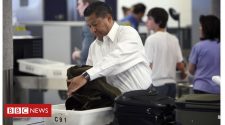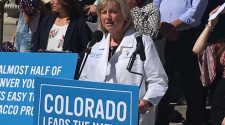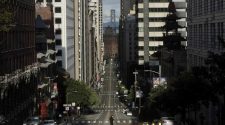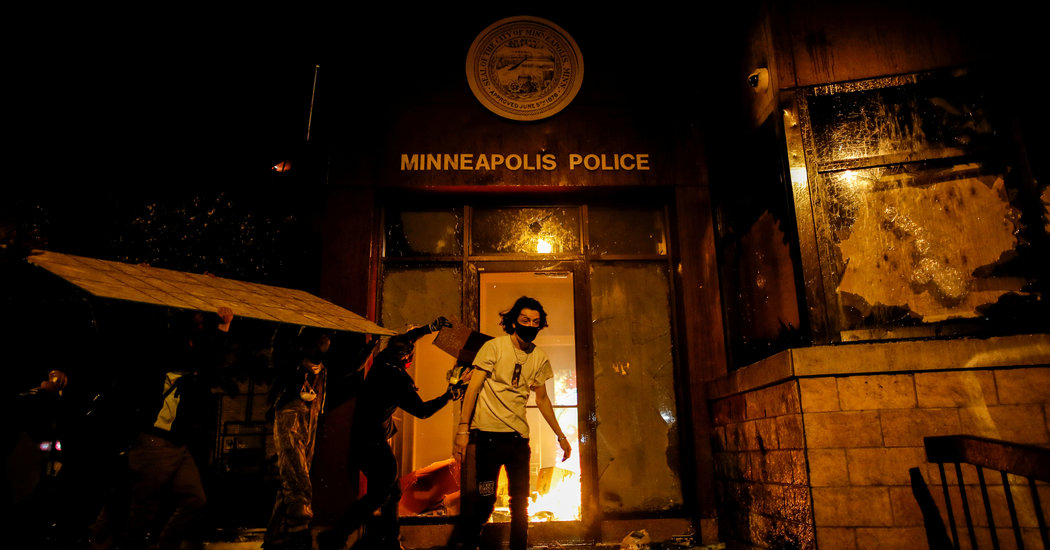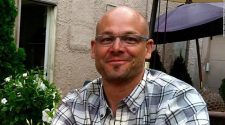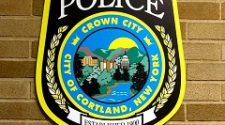As a police station burned, Trump threatened violence against those protesting a death in police custody.
A Minneapolis police station was overrun and set ablaze by protesters Thursday night as destructive demonstrations raged in the city and spread across the country overnight Friday after the death of George Floyd, an African-American man, in police custody.
He died after pleading, “I can’t breathe,” while a white police officer pressed his knee into his neck. The death set off days of continuing protests and scattered looting of stores in the city, as demonstrators denounced another in a long line of fatal encounters between African-Americans and law enforcement officers.
President Trump, who previously called the video of Mr. Floyd’s death “shocking,” later called the protesters “thugs” on Twitter and said that “when the looting starts, the shooting starts,” prompting the social media network to attach a warning to the tweet, saying that it violated the company’s rules about “glorifying violence.”
The spectacle of a police station in flames and a president appearing to threaten violence against those protesting the death of a black man in police custody — set against the backdrop of a coronavirus pandemic that has kept many residents from engaging with one another directly for months — added to the anxiety of a nation already plagued by health and economic crises.
Tera Brown, Mr. Floyd’s cousin, has said: “I want to see action. This was clearly murder.”
The demonstration near the Minneapolis Police Department’s Third Precinct grew more intense in the hours after prosecutors said that they had not decided whether to charge the officer videotaped pressing his knee into Mr. Floyd’s neck for about eight minutes.
The protests have spread across the state, leading to the evacuation on Thursday afternoon of lawmakers and employees from the State Capitol in St. Paul as a precaution.
Other protests — many peaceful, some convulsed by violence — were reported across the country.
The State Capitol in Denver was put on lockdown after someone fired a gun near a peaceful demonstration, and protests in Columbus, Ohio, turned chaotic as crowds surging up the steps of the State Capitol and broke windows, videos posted by news outlets showed. The Columbus Dispatch reported that officers also used pepper spray on large crowds of demonstrators downtown after a few protesters tossed smoke bombs and water bottles at lines of officers.
In Phoenix, hundreds of protesters marched toward the State Capitol with relative calm, according to news reports, before tense face-offs with police officers later in the night.
The anger and the rage in Minneapolis have been building for days.
After prosecutors announced on Thursday that they had not decided whether to charge the police officer who was caught on video with his knee pressed against the neck of George Floyd as the man begged for air, that rage turned to chaos.
Outside the Minneapolis Police Department’s Third Precinct station house, the crowds surged, with some people tossing fireworks and other items at officers, while the police fired projectiles back.
The standoff soon spiraled out of control, with officers retreating from the police station in vehicles just after 10 p.m. Thursday local time as protesters stormed the building — smashing equipment, lighting fires and setting off fireworks, according to videos posted from the scene.
“We’re starting fires in here, so be careful,” one man could be heard shouting as sprinklers doused protesters who had burst inside. Flames rose from the front of the building as hundreds of protesters looked on, and soon smoke was billowing from the roof.
Mayor Jacob Frey of Minneapolis said at a news conference Friday morning that he had made the call for officers to flee the Third Precinct, saying, “The symbolism of a building cannot outweigh the importance of life.”
Mr. Frey, a Democrat, said he understood the anger of the city’s residents but pleaded with people to stop destroying property and looting stores. “It’s not just enough to do the right thing yourself,” he said. “We need to be making sure that all of us are held accountable.”
Mr. Frey also gave a fiery retort to Mr. Trump’s tweets during a news conference Friday morning.
“Weakness is refusing to take responsibility for your own actions,” he said. “Weakness is pointing your finger at somebody else during a time of crisis.”
“Donald Trump knows nothing about the strength of Minneapolis,” he added.
As the unrest escalated, Gov. Tim Walz of Minnesota activated the National Guard and declared a state of emergency in the Twin Cities after he saw the level of destruction from Wednesday’s protest — buildings on fire, clashes with the police and looted stores. Five hundred members of the Minnesota National Guard were sent to Minneapolis and St. Paul, the state capital.
“Unfortunately, some individuals have engaged in unlawful and dangerous activity, including arson, rioting, looting, and damaging public and private property,” Mr. Walz wrote in his proclamation. “These activities threaten the safety of lawful demonstrators and other Minnesotans, and both first responders and demonstrators have already been injured.”
The company prevented users from viewing Mr. Trump’s message without first reading a brief notice describing the rule violation. Twitter also blocked users from liking or replying to Mr. Trump’s post.
But Twitter did not take the message down, saying it was in the public interest for the president’s words remain accessible.
Mr. Trump’s tweet about the Minneapolis protests echoed a comment by Walter E. Headley, the Miami police chief who attracted national attention in the late 1960s for using shotguns, dogs and other heavy-handed policies to fight crime in the city’s black neighborhoods.
Mr. Headley announced a “get tough” campaign in a December 1967 news conference that prompted angry reactions from black leaders, The New York Times reported at the time.
“We haven’t had any serious problems with civil uprising and looting,” he said, “because I’ve let the word filter down that when the looting starts, the shooting starts.”
“We don’t mind being accused of police brutality,” Mr. Headley also said at that news conference. “They haven’t seen anything yet.”
Peaceful protests against the death of George Floyd turned chaotic in several cities on Thursday night into Friday morning, with the Denver State Capitol put on lockdown after someone fired a gun near a demonstration, and crowds in Columbus, Ohio, surging up the steps of the State Capitol and breaking windows.
Leslie Herod, a state representative in Colorado, said she had heard several shots near the Denver Statehouse. The Police Department said no injuries were immediately reported.
In Ohio, the police could be seen rushing to the Capitol and ordering protesters to disperse, while downtown, officers used pepper spray on large crowds.
Similar episodes occurred in Phoenix, where hundreds of protesters marched toward the State Capitol relatively calmly before gatherings grew more tense through the night, as some protesters threw stones at the city’s Police Department.
Near the Phoenix State Capitol, a pregnant woman was photographed in apparent pain on the ground. A reporter wrote on Twitter that she had been pepper sprayed.
A video taken at the Denver protest appeared to show the driver of a black S.U.V. plowing through a crowd of protesters who had blocked traffic near the Statehouse. As a protester jumped off the car, the driver sped up and knocked into him. It was unclear whether the protester had been wounded.
“I share the immense anguish we all feel about the unjust murder of George Floyd,” Gov. Jared Polis of Colorado said in a statement. “But let me be clear, senseless violence will never be healed by more violence.”
More than 40 people were arrested on Thursday night in Manhattan as hundreds of New Yorkers joined the nationwide protests. One woman taken into custody at Union Square yelled, “Black lives matter!” as officers dragged her to a police wagon, a video posted online showed.
Images on social media showed sometimes-chaotic scenes in New York as the mostly young protesters clashed with uniformed officers. Some protesters carried signs that read, “No Justice, No Peace” and chanted, “I can’t breathe.”
A CNN crew covering the protests is arrested on live television.
As cameras were rolling, capturing the efforts by the authorities to reestablish control over an area of Minneapolis still smoldering after a night of destruction, the police in Minneapolis arrested members of a CNN crew on live television.
The episode, which took place shortly after 5 a.m. in Minnesota, captured the tension on the streets of the city and came after a tumultuous night marked by burning buildings, looting and general unrest.
The morning anchors on CNN said that Omar Jimenez, a correspondent based in Chicago, had been arrested. In the moments before the arrest, Mr. Jimenez could be heard clearly identifying himself as a reporter and offering to move wherever he and his crew were directed.
Instead, he was placed in custody. The camera kept rolling even as it was left on the ground.
CNN said that a producer and a camera operator had also been taken into custody, and it called on the Minnesota authorities, including the governor, to release them immediately.
“There’s a level of heavy-handedness that we’re not used to,” said Josh Campbell, a CNN correspondent who was also reporting from Minneapolis.
“That’s our camera being taken into custody,” said Alisyn Camerota, a co-host of the broadcast, as a police officer picked up a piece of broadcasting equipment after the crew was detained. “Our correspondent couldn’t have been more cool and cooperative.”
John Berman, her on-air partner, said the CNN legal department was now involved. “We’re not the story, tonight,” Mr. Berman said.
As the episode with the CNN crew played out, lines of police officers moved down the street, calling over loudspeakers for crowds to disperse as dawn broke.
For police trainers and criminologists, the episode appears to be a textbook case of why many police departments across the country have sought to outright ban or limit the use of chokeholds or other neck restraints in recent years: The practices have too often turned fatal.
“It is a technique that we don’t use as much anymore because of the vulnerability,” said Mylan Masson, a former police officer who ran a training program for the Minneapolis police for 15 years until 2016. “We try to stay away from the neck as much as possible.”
Department records indicate, however, that the Minneapolis police have not entirely abandoned the use of neck restraints, even if the method used by Officer Chauvin is no longer part of police training.
The Minneapolis Police Department’s manual states that neck restraints and chokeholds are basically reserved only for when an officer is caught in a life-or-death situation. There was no such apparent threat during Mr. Floyd’s detention.
Criminologists viewing the tape said that the knee restraint not only put dangerous pressure on the back of the neck, but that Mr. Floyd was also kept lying on his stomach for too long. Both positions — the knee on the neck and lying face down — run the risk of cutting off the oxygen supply.
The investigation will be led by the U.S. attorney in Minnesota, Erica MacDonald, and by F.B.I. agents in Minneapolis. Attorney General William P. Barr and the head of the Justice Department’s civil rights division, Eric Dreiband, are closely monitoring their inquiry, a Justice Department spokeswoman said.
“The Department of Justice has made the investigation a top priority and has assigned experienced prosecutors and F.B.I. criminal investigators to the matter,” the department said in a statement.
The department noted that is a violation of federal law for an officer acting in an official capacity to deprive another person of his or her constitutional rights, including the right to be protected from cruel and unusual punishment.
State and federal prosecutors are running simultaneous investigations into Mr. Floyd’s death after a video showed Derek Chauvin, a white police officer, pressing his knee on the neck of Mr. Floyd, who is black, as Mr. Floyd’s body became limp.
Mr. Chauvin and three other officers at the scene, who did nothing to stop Mr. Chauvin, were fired on Tuesday, and Mayor Jacob Frey of Minneapolis has called for Mr. Chauvin to be arrested and charged. The Minneapolis Police Department has identified the other officers as Thomas Lane, Tou Thao and J. Alexander Kueng.
State prosecutors said early Thursday night that they had not yet decided whether to charge any of the four Minneapolis police officers.
The Justice Department has declined to charge police officers in other high-profile cases in which a black person has died in their custody.
In July, after a five-year investigation, the department said it would not bring federal civil rights charges against Daniel Pantaleo, the Staten Island police officer who killed Eric Garner by wrapping his arm around his neck. The killing was caught on video and widely circulated online.
The decision bitterly divided the Justice Department’s civil rights division lawyers, who wanted to charge Mr. Pantaleo, and prosecutors in Brooklyn, who believed they could not win the case at trial.
Mr. Barr ultimately sided with the Brooklyn prosecutors, who had argued that they did not have enough evidence to prove that Mr. Panataleo committed a federal civil rights violation because they could not prove that he had made a clear decision to use a chokehold, which the New York Police Department had banned, when he killed Mr. Garner.
Like Mr. Floyd, Mr. Garner also gasped, “I can’t breathe” before he died.
Democrats on the House Judiciary Committee asked the Justice Department on Thursday to investigate Mr. Floyd’s death along with the recent killings of two other black people: Ahmaud Arbery, who was shot after being pursued by white men near Brunswick, Ga.; and Breonna Taylor, who was killed by police officers in Louisville, Ky., during a “no-knock” raid of her apartment. On Thursday night, seven people were struck by gunfire at a protest in Louisville, Ky., over the death of Ms. Taylor.
The committee members asked the department to open so-called pattern and practice investigations into potential police misconduct in all three cases. Federal law prohibits law enforcement officers from engaging in a pattern or practice of conduct that deprives people of their constitutional rights.
They also asked that the department investigate the local prosecutors who were involved in Mr. Arbery’s case. The two armed men who chased Mr. Arbery had connections to local law enforcement and were not arrested for 74 days, until after a video of the shooting was widely circulated.
Mr. Arbery’s death and the subsequent local investigation “are reminiscent of early 20th century lynchings in the Jim Crow South,” the committee members wrote.
Jerry Nadler, the chair of the committee, said it is considering legislation to address racial profiling and the excessive use of force by police officers.
He noted that the Justice Department has uncovered rampant police abuses in Ferguson, Mo., Baltimore, Cleveland and Chicago, which led the police departments in those cities to negotiate consent decrees with the federal government.
Mr. Floyd’s sister, Bridgett Floyd, called for justice on NBC’s “Today” show.
“I would like for those officers to be charged with murder because that’s exactly what they did,” Ms. Floyd said.
“I don’t want the protests to be for just show,” said Tera Brown, Mr. Floyd’s cousin, who appeared with two of Mr. Floyd’s brothers. “I want to see action.”
“This was clearly murder,” she added. “We want to see them arrested; we want to see them charged; we want to see them convicted for what they did.”
Stephen Jackson, the former N.B.A. player and now podcast host, told “The Today Show” on Thursday that the death of Mr. Floyd, a longtime friend, “destroyed” him.
“I jumped up, screamed, scared my daughter and almost broke my hand punching stuff because I was so mad,” Mr. Jackson said, describing his reaction when he learned the news.
Mr. Jackson told “The Breakfast Club” podcast that he grew up with Mr. Floyd in the Houston area. He joked that they looked so much alike that they could have the same father, so would refer to each other as “Twin.”
“Neighborhoods, they all get beefing,” Mr. Jackson said. “But you always have one guy that can go to all the neighborhoods and everybody will rock with him. Floyd was that guy.”
Excessive force complaints against Minneapolis officers have become commonplace, especially by African-American residents. One of the officers involved in Mr. Floyd’s death, Mr. Chauvin, 44, had several complaints filed against him, three of which led to reprimands for his language and tone.
Mr. Chauvin shot a man who was trying to grab an officer’s gun in 2008, according to The Pioneer Press. He was also present at two other shootings, one of them fatal, but it was unclear if he fired his weapon in those cases, according to Communities United Against Police Brutality, a local organization advocating police reform.
African-Americans account for about 20 percent of the city’s population, but they are more likely to be pulled over, arrested and have force used against them than white residents, Police Department data shows. And black people accounted for more than 60 percent of the victims in Minneapolis police shootings from late 2009 through May 2019, data shows.
Yet there is a deep rift between the city’s police force — which also is predominantly white — and the community, one that seems to grow larger with each killing.
Reporting was contributed by Marc Santora, Elian Peltier, Raymond Zhong, Russell Goldman, Mike Wolgelenter, Victoria Bekiempis, Katie Benner, Nicholas Bogel-Burroughs, Audra D.S. Burch, Sopan Deb, John Eligon, Matt Furber, Jack Healy, Dan Levin, Edgar Sandoval and Neil Vigdor.

